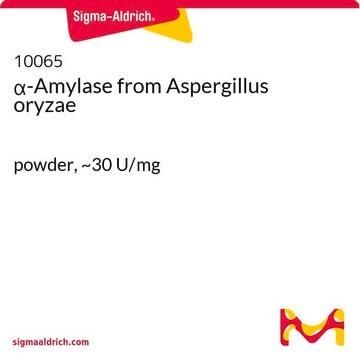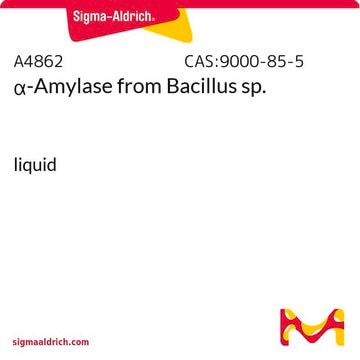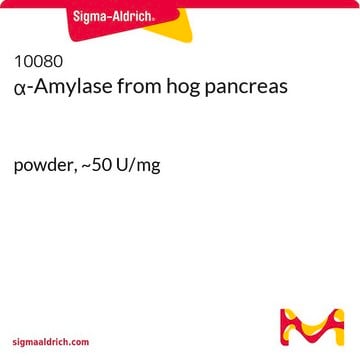This product is soluble in water. No additional calcium is required. For specific applications it may also be prepared in typical sodium or potassium phosphate buffer solutions.
10069
α-Amylase from Bacillus sp.
powder, yellow-brown, ~380 U/mg
Scegli un formato
CHF 88.80
Scegli un formato
About This Item
CHF 88.80
Prodotti consigliati
Origine biologica
Bacillus sp.
Stato
powder
Attività specifica
~380 U/mg
Caratteristiche più verdi
Waste Prevention
Design for Energy Efficiency
Learn more about the Principles of Green Chemistry.
sustainability
Greener Alternative Product
Colore
yellow-brown
Categoria alternativa più verde
, Enabling
Temperatura di conservazione
2-8°C
Cerchi prodotti simili? Visita Guida al confronto tra prodotti
Categorie correlate
Descrizione generale
Applicazioni
- as a dispersal enzyme to test degradation of S. aureus biofilms[2],
- in the enzymatic hydrolysis of tapioca starch[3]
- in the enzymolysis of plant-based native and the amorphous granular starches[4]
Azioni biochim/fisiol
Definizione di unità
Avvertenze
Danger
Indicazioni di pericolo
Consigli di prudenza
Classi di pericolo
Resp. Sens. 1
Codice della classe di stoccaggio
11 - Combustible Solids
Classe di pericolosità dell'acqua (WGK)
WGK 1
Punto d’infiammabilità (°F)
Not applicable
Punto d’infiammabilità (°C)
Not applicable
Dispositivi di protezione individuale
dust mask type N95 (US), Eyeshields, Faceshields, Gloves
Scegli una delle versioni più recenti:
Possiedi già questo prodotto?
I documenti relativi ai prodotti acquistati recentemente sono disponibili nell’Archivio dei documenti.
I clienti hanno visto anche
-
In which solution I should to dissolve the alfa amylase? should had ca+2? (for starch degradation)
1 answer-
Helpful?
-
Active Filters
Il team dei nostri ricercatori vanta grande esperienza in tutte le aree della ricerca quali Life Science, scienza dei materiali, sintesi chimica, cromatografia, discipline analitiche, ecc..
Contatta l'Assistenza Tecnica.












